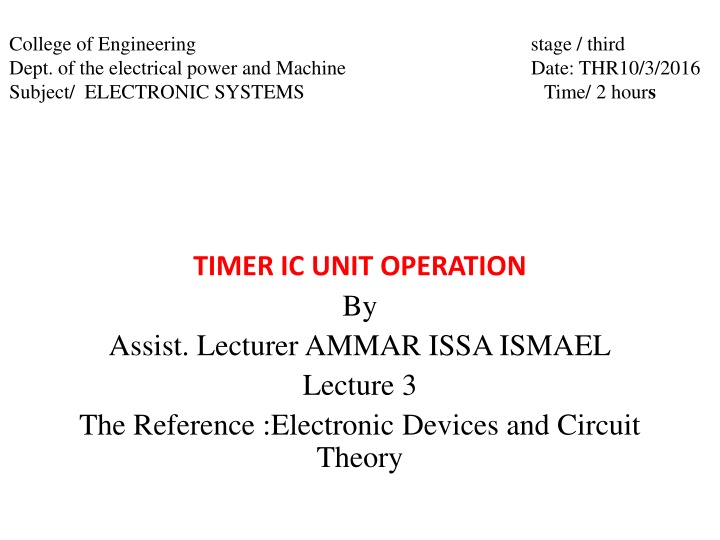
IC 555 Timer Operations: Astable & Monostable Circuits Explained
Explore the working principles of IC 555 timer in electronic systems focusing on astable and monostable circuits. Learn about voltage levels, comparator functions, capacitor charging, and output waveforms. Discover how to use IC 555 as a clock circuit and one-shot multivibrator. Gain insights into setting timing intervals and calculating high/low output durations.
Uploaded on | 0 Views
Download Presentation

Please find below an Image/Link to download the presentation.
The content on the website is provided AS IS for your information and personal use only. It may not be sold, licensed, or shared on other websites without obtaining consent from the author. If you encounter any issues during the download, it is possible that the publisher has removed the file from their server.
You are allowed to download the files provided on this website for personal or commercial use, subject to the condition that they are used lawfully. All files are the property of their respective owners.
The content on the website is provided AS IS for your information and personal use only. It may not be sold, licensed, or shared on other websites without obtaining consent from the author.
E N D
Presentation Transcript
College of Engineering Dept. of the electrical power and Machine Subject/ ELECTRONIC SYSTEMS Time/ 2 hours stage / third Date: THR10/3/2016 TIMER IC UNIT OPERATION By Assist. Lecturer AMMAR ISSA ISMAEL Lecture 3 The Reference :Electronic Devices and Circuit Theory
IC 555 timer Another popular analog digital integrated circuit is the versatile 555 timer. The IC is made of a combination of linear comparators and digital flip flops as described in Fig. 17.16. The entire circuit is usually housed in an 8-pin package as specified in Fig. 17.16. A series connection of three resistors sets the reference voltage levels to the two comparators at 2VCC/3 and VCC/3, the output of these comparators setting or resetting the flip-flop unit. The output of the flip-flop circuit is then brought out through an output amplifier stage. The flip-flop circuit also operates a transistor inside the IC, the transistor collector usually being driven low to discharge a timing capacitor.
IC 555 timer One popular application of the 555 timer IC is as an astable multivibrator or clock circuit. Figure 17.17 shows an astable circuit built using an external resistor and capacitor to set the timing interval of the output signal. Capacitor C charges toward VCC through external resistors RA and RB. Referring to Fig. 17.17, the capacitor voltage rises until it goes above 2VCC/3. This voltage is the threshold voltage at pin 6, which drives comparator 1 to trigger the flip-flop so that the output at pin 3 goes low. In addition, the discharge transistor is driven on, causing the output at pin 7 to discharge the capacitor through resistor RB. The capacitor voltage then decreases until it drops below the trigger level (VCC/3). The flipflop is triggered so that the output goes back high and the discharge transistor is turned off, so that the capacitor can again charge through resistors RA and RB toward VCC.
Figure 17.18a shows the capacitor and output waveforms resulting from the astable circuit. Calculation of the time intervals during which the output is high and low can be made using the relations
Monostable Operation The 555 timer can also be used as a one-shot or monostable multivibrator circuit, as shown in Fig. 17.19. When the trigger input signal goes negative, it triggers the oneshot, with output at pin 3 then going high for a time period Referring back to Fig. 17.16, the negative edge of the trigger input causes comparator 2 to trigger the flip-flop, with the output at pin 3 going high. Capacitor C charges toward VCC through resistor RA. During the charge interval, the output remains high. When the voltage across the capacitor reaches the threshold level of 2VCC/3, comparator 1 triggers the flip-flop, with output going low. The discharge transistor also goes low, causing the capacitor to remain at
Figure 17.19b shows the input trigger signal and the resulting output waveform for the 555 timer operated as a one-shot. Time periods for this circuit can range from microseconds to many seconds, making this IC useful for a range of applications
VOLTAGE-CONTROLLED OSCILLATOR A voltage-controlled oscillator (VCO) is a circuit that provides a varying output signal (typically of square-wave or triangular-wave form) frequency can be adjusted over a range controlled by a dc voltage. example of a VCO is the 566 IC unit, which contains circuitry to generate both square- wave and triangular-wave signals. frequency is set by an external resistor and capacitor and then varied by an applied dc voltage.
Figure 17.21a shows that the 566 contains current sources to charge and discharge an external capacitor C1 at a rate set by external resistor R1 And the modulating dc input voltage. A Schmitt trigger circuit is used to switch the current sources between charging and discharging the capacitor, and the triangular voltage developed across the capacitor and square wave from the Schmitt trigger are provided as outputs through buffer amplifiers. Figure 17.21 A 566 function generator: (a) block diagram;
Figure 17.21b shows the pin connection of the 566 unit and a summary of formula and value limitations. The oscillator can be programmed over a 10-to-1 frequency range by proper selection of an external resistor and capacitor, and then mod-ulated over a 10-to-1 frequency range by a control voltage,VC . A free-running or center- operating frequency, fo, can be calculated from Figure 17.21 A 566 function generator:(b) pin configuration and summary of operating data
Figure 17.22 shows an example in which the 566 function generator is used to provide both square-wave and triangular-wave signals at a fixed frequency set by R1,C1, and VC. A resistor divider R2 and R3 sets the dc modulating voltage at a fixed value.
PROBLEMS chapter 17 The problems 1 to 19
